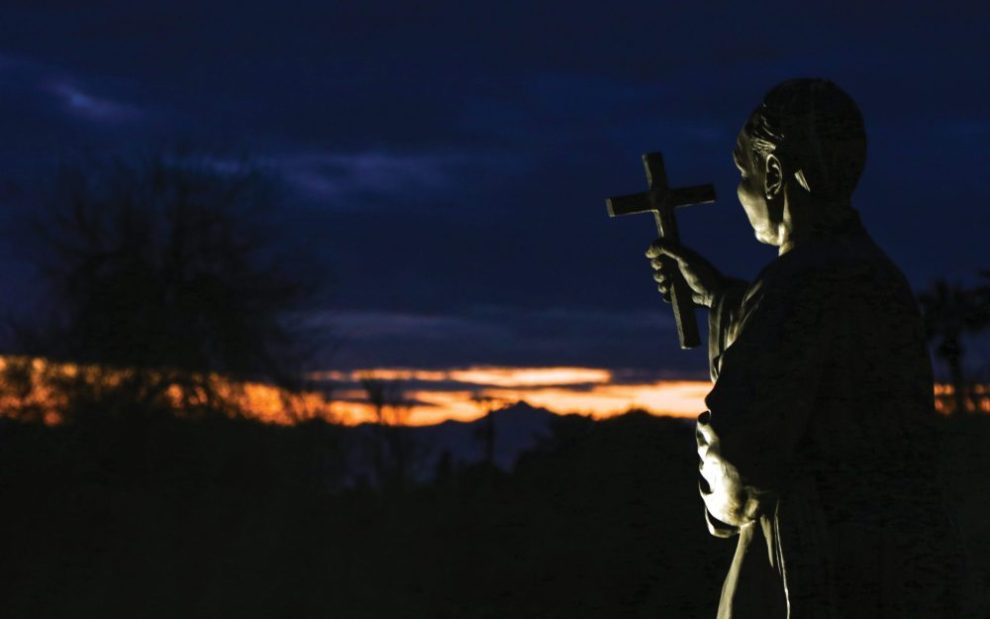Sometime in the summer of 1829, a young Spanish man, Anthony Claret, was walking along a beach in Barcelona. The 20-year-old cloth merchant was suffering from what today might be called burnout: He was overworked and, prone to ill health and stomach maladies, losing his appetite.
“The only relief I could find was to go down to the sea, wade in it, and drink a few drops of the salt water,” he wrote of that summer in his autobiography. He was walking on the beach near the seaside neighborhood of La Barceloneta, when, he said, “a huge wave suddenly engulfed me and carried me out to sea.”
Despite the danger, Claret found himself enveloped in an exceeding calm. “I saw in a moment that I was far from shore, and I was amazed to see that I was floating on the surface, although I didn’t know how to swim,” he wrote. “I called out to the Blessed Virgin and found myself on shore without having swallowed even a drop of water.”
It was not until he was safely back on shore that he fully realized the danger he had been in that he had escaped, he said, “through the help of the Blessed Virgin.”
Young Claret
St. Anthony Mary Claret was the fifth of John and Josefa Claret’s 11 children—six of his brothers and sisters died under the age of 15. He was born just before Christmas 1807 in northern Spain and baptized on Christmas Day in Sallent, a village a few miles northwest of Manresa, outside of Barcelona, where a saint he admired—Ignatius of Loyola—experienced a spiritual awakening.
His village was also near the Marian shrine of Fussimanya, where Claret and his sister would walk frequently to pray the rosary. “Even before I got there, as soon as I could see the outline of the chapel, I felt so emotional that tears of tenderness welled up in my eyes,” he wrote.
From a young age, Claret was drawn to relieve the spiritual and physical misery of others. “I am so soft-hearted and compassionate that I can’t bear seeing misfortune or misery without doing something to help,” he wrote of his childhood self. “I would take the bread out of my own mouth to give it to the poor.”
Young Claret, living during a great age of missions, desired to put his faith into action as a missionary. As the 19th century’s advancements in travel and communications promoted global colonial expansion, European missionaries utilized these new avenues to promote the Christian faith in “missionary fields” abroad. From a very young age, Claret desired to be a priest—even studying Latin in preparation for seminary—but his family of weavers and textile merchants expected him to work in their business, so at 18, he moved to Barcelona to study and practice his trade.
Only a couple years later, however, his miraculous experience on the beach strengthened his already powerful devotion to Mary, and he decided to seek religious life. After considering joining the Carthusians, Claret entered seminary and was ordained a priest on June 13, 1835. He then entered the Jesuit novitiate, intending to become a missionary abroad. His poor health, however, required him to abandon those dreams. He left the Jesuits, and, in 1849, in response to a prompting of the Spirit, founded the Congregation of Missionary Sons of the Immaculate Heart of Mary.
A decade after founding this new congregation, on the morning of September 23, 1859, Claret received three visions from Jesus, detailing three impending global scourges for the upcoming century: communism, widespread hedonism and idolization of money. and catastrophic wars.
Although these visions may sound like an ossified relic of 19th-century spirituality, they serve as pertinent “signs of the times,” as these themes showed up repeatedly in Claret’s life and ministry. These themes also show the enduring value of his work today.
The perils of war
“History is everything,” says Malachy McCarthy, an archivist who organized the Claretian Archives in Chicago before retiring in 2022. “Claret lived during the worst part of Spanish history,” he says. (By worse, he clarifies, he means tumultuous.)
Claret personally experienced the tumult of war. For most of his life, Claret remained in his home country of Spain, where he founded a publishing company and wrote hundreds of pamphlets and theological tracts. In 1810, revolution broke out in Mexico, and the Spanish Empire slowly lost control of Mexico and its other colonies in the Western Hemisphere. But Spain controlled Cuba until the turn of the 20th century, and in 1850, Pope Pius IX appointed Claret the archbishop of Santiago de Cuba.
Claret spent six years there, supporting both the nascent church and poor Catholics in the country. He returned to Spain to serve as a confessor to Queen Isabella II—the only queen who reigned as absolute monarch, rather than queen consort, in Spanish history.
Then, in 1868, the so-called Glorious Revolution deposed Queen Isabella. Claret, as her chaplain, was sent into exile alongside her. After a brief visit to Rome during the First Vatican Council, during which he spoke in favor of papal infallibility, Claret died in 1870 at a monastery in France, still in exile.
Claret’s 1853 vision goes far beyond his own personal experience. It warned of wars that would engulf and horrify the world. As McCarthy points out, Claret lived during the “long 19th century” of revolutions in Europe. He was beatified between the world wars and canonized following World War II. Amid this tumultuous history, Claret developed his strong sense of vocation. “Claret was a missioner,” McCarthy says. “He felt the most important thing was to heal society.”
Worldwide violence has accelerated, not abated, since Claret’s vision. War and threat of war have become constant scourges; violence is the basso continuo in our society. The inhumane scale of war continues to grow: from mustard gas in the trenches of World War I to fire-bombing and atomic warfare in World War II to the napalm of Vietnam to the all-out war against civilians that has become a feature of conflicts in Syria, Ukraine, Afghanistan, and Gaza.
Trauma psychologists, modern historians, and theologians have remarked on how the past century of war has destroyed the social fabric, even among people far from the front lines of battle. Endless warfare has maimed our collective humanity. Claret’s vision of a social fabric wounded by war remains prescient more than 170 years later.
“The enchantments of Mammon”
The second scourge that Claret noted in his visions was a hedonistic love of money that would consume the globe. However, Claret demonstrated a cure for what he called the “enchantment of Mammon”—voluntary poverty. As a missionary in Spain and later as a bishop, Claret practiced simplicity and poverty.
Claret helped Cuban peasants learn modern agricultural techniques and founded credit unions at parishes to provide capital for people who didn’t have access to banks. “For I saw that when the poor have proper direction and are given a decent means to earn a living, they are upright citizens,” Claret wrote in his autobiography. “My eagerness to help them was as much spiritual as it was material.”
Claret served as a bishop in Santiago de Cuba for less than a decade, but his work continued long after he returned to Europe. As greed and inequality metastasize—the top 10 percent of Americans hold 60 percent of the country’s wealth, according to an October 2024 report from the Congressional Budget Office—the commitment of the Claretians to creating new institutions based on human dignity continues Claret’s missionary work.
In the United States, his missionaries carry on his legacy of creating more just structures, based on Catholic social teaching, that make the lives of the disenfranchised more dignified. “Claretians are always going into troubled situations,” McCarthy says. He cites the work of the Claretian Associates in South Chicago, where they started a neighborhood health clinic—now Chicago Family Health Center—and homes for the elderly—South Chicago Senior Housing.
The Claretians founded many of their parishes in underserved neighborhoods, McCarthy notes, and are committed to working for the poor—not in a symbolic way, but in ways that will materially improve lives. “The Claretians will get their hands dirty,” he says.
The reign of materialism
Claret’s final vision warned of the spreading of “communism’s errors.” Claret founded the Congregation of Missionary Sons of the Immaculate Heart of Mary in 1849—a year after Karl Marx and Friedrich Engels published The Communist Manifesto.
Claret’s canonization was supported by a rather infamous Catholic, Generalissimo Francisco Franco, the dictator of Spain, who was scheduled to lead a pilgrimage of 30,000 Spaniards to Rome for Claret’s canonization Mass. During the Spanish Civil War, 109 Claretians were killed by the separatist Republican army, who fought against Franco and his Loyalist forces. Franco did not end up attending Claret’s 1950 canonization, but his wife, Carmen Polo, the First Lady of Spain, attended with her children.
However, Claret’s teachings are not in line with fascism any more than they are communism. Instead, they suggest what Emmanuel Mounier, the French thinker who inspired Dorothy Day and Peter Maurin’s creation of the Catholic Worker, calls personalism, a third way and an alternative to these two philosophies.
The problem with communism, Mournier said, is that it considered labor and inequality solely in material terms. But being a person means being in relationship, so our rights and freedoms must always be oriented toward the whole community’s flourishing. Personalism contends that communism had no solution to the spiritual oppressions of the industrial age. Living a dignified life requires both adequate material conditions and care for a person’s spiritual needs.
Pope Francis echoes this in Evangelii Gaudium (On the Proclamation of the Gospel in Today’s World): “The worst discrimination which the poor suffer is the lack of spiritual care. Our preferential option for the poor must mainly translate into a privileged and preferential religious care.”
Claret also emphasized the importance of healing spiritual wounds as well as bettering material conditions. His ministry of spiritual instruction underscores the importance of accompanying the corporal works of mercy with the spiritual works of mercy.
Although he left the Jesuits after his novitiate, Claret continued to lead many clergy in Cuba in the Ignatian Spiritual Exercises.
And, during a time when roughly half the population of Spain was illiterate, Claret wrote extensively and promoted the printing press and the publication of religious books. He admired many female spiritual authors, including doctors of the church Teresa of Àvila and Catherine of Siena.
Inspired by the hundreds of theological tracts Claret wrote, the Congregation of Missionary Sons of the Immaculate Heart of Mary has also committed itself to publishing, spreading the faith through the written word. In 1902, the Claretians came to the United States and began founding multiple newspapers and magazines. In 1935, the year after Pope Pius XI beatified Claret, the Claretian Missionaries in the United States published The Voice of St. Jude, which, in 1963, was renamed U.S. Catholic. Over the years, the Claretians in the United States have published books and pamphlets, put out radio broadcasts, and are now expanding to multimedia initiatives such as videos and podcasts.
Claret’s visions spoke to the tumultuous and violent political situation, the plight of the poor in a world consumed by greed and excess, and the primacy of the spiritual. Although parsed in old-fashioned language, Claret’s visions speak prophetically to the hopes, fears, and pains of the 21st century.
This article also appears in the June 2025 issue of U.S. Catholic (Vol. 90, No. 6, pages 23-25). Click here to subscribe to the magazine.
Image: Flickr.com/Fr. Lawrence Lew, O.P.














Add comment